Pigeon pea
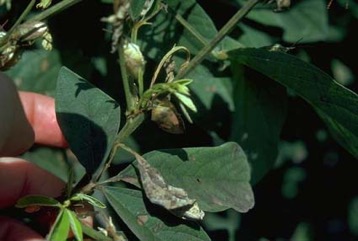
A tropical plant. Plants require a tropical or subtropical climate. Plants grow from sea level up to about 1800 m in the tropics. They can tolerate drought and are suited to a drier climate. They can grow in places with less than 600 mm rainfall per year. They do less well in the wet tropics. It suffers in waterlogged soils and is damaged by frost. It can also tolerate heat. It will grow on poor soils. It cannot grow on salty soils. It grows to about 2000 m in Nepal. It can grow in arid places. It suits hardiness zones 10-12. In Sichuan and Yunnan.
Also known as:
Adhaki, Aduwa, Ambarivatra, Ambiatry, Ambrevade, Angola pea, Apena, Arhar, Arhar dhal, Arhat, Arhor, Asedua, Atiyi, Bak tua heea, Behiang, Behieng, Belhang, Betleng, Biefoyoo, Blofoyoo atii, Bo-chang, Burusu, Caiano, Catjang, Chinchonchillo, Congo pea, Daal, Dahl, Dau-chieu, Dau-sang, De bei nie jian, Dhal, Ekilimite, E-konshon, Enkuuku, Feijao-guandu, Gandul, Gandules, Gandures, Golobji grah, Guandu, Hpunlasi, Phyan, Kacang dal, Kandulu, Klekoun, Kongo-binch, Konsotoge, Lapena, Lapenda, Mbwengwe, Mu do, Mugu tholhi, Nandolo, Ne qie ke lie, Ngoliolio, No-eye pea, Nzuu, Lothlodi, Orohor, Osungi, Osugina, Otile, Otili, Paltiyu, Pe-sin-gon, Pijonpii, Pois cajun, Puspu-poroto, Rahar, Red gram, Salbuko-geed, Samdaek khloeng, Sewpi, Thekek, Thovaray, Thuvara, Tiyi, Togare, Toor, Tourhea, Tua heea, Tukai, Tur, Tuur, Tuvari, Tuvarika, Tuver, Tuye, Umukuunde, Urhur, Viovio, Wabin butsuka, Waken turuwa, Wando, Wandu, Wenali, Wewof ater, Yepetum
Synonyms
- Cajanus indicus Sprengel
- Cajanus bicolor DC.
- Cajanus flavus DC., nom. illeg.
- Cajanus indicus Spreng., nom. illeg.
- Cajanus indorum Millsp.
- Cajanus inodorum Medik.
- Cajanus luteus Bello
- Cajanus obcordifolius V. Singh
- Cajanus pseudo-cajan (Jacq.) Schinz & Gillaumin
- Cajanus striatus Bojer
- Cytisus cajan L.
- Cytisus guineensis Schum. & Thonn. Cytisus pseudo-cajan Jacq.
- Phaseolus balicus L.
Edible Portion
- Seeds, Leaves, Pods, Sprouts, Vegetable
Where does Pigeon pea grow?
Found in: Afghanistan, Africa, Angola, Anguilla, Antigua-Barbuda, Asia, Australia, Azerbaijan, Bahamas, Bangladesh, Barbados, Belize, Benin, Bhutan, Bolivia, Botswana, Brazil, Burkina Faso, Burundi, Cambodia, Cameroon, Caribbean, Caucasus, Central Africa, Central African Republic, CAR, Central America, Chad, China, Colombia, Comoros, Congo DR, Costa Rica, Côte d'Ivoire, Cuba, Djibouti, Dominica, Dominican Republic, East Africa, East Timor, Ecuador, Egypt, El Salvador, Eritrea, Eswatini, Ethiopia, Fiji, French Guiana, French Polynesia, Gabon, Gambia, Georgia, Ghana, Grenada, Guadeloupe, Guatemala, Guianas, Guinea, Guinée, Guinea-Bissau, Guyana, Haiti, Hawaii, Himalayas, Honduras, India, Indochina, Indonesia, Ivory Coast, Jamaica, Japan, Kenya, Laos, Liberia, Madagascar, Malawi, Malaysia, Maldives, Mali, Marianas, Marquesas, Martinique, Mauritania, Mauritius, Mexico, Montserrat, Mozambique, Myanmar, Namibia, Nauru, Nepal, New Caledonia, Nicaragua, Niger, Nigeria, Niue, North Africa, North America, Northeastern India, Oman, Pacific, Pakistan, Panama, Papua New Guinea, PNG, Peru, Philippines, Puerto Rico, Reunion, Rotuma, Rwanda, Sao Tome and Principe, SE Asia, Senegal, Seychelles, Sierra Leone, Slovenia, Solomon Islands, Somalia, South Africa, Southern Africa, South America, South Sudan, Sri Lanka, St Lucia, Sudan, Suriname, Swaziland, Tahiti, Taiwan, Tanzania, Thailand, Timor-Leste, Togo, Trinidad, Turkey, Uganda, United States, Vanuatu, Venezuela, Vietnam, West Africa, West Indies, West Timor, Yemen, Zambia, Zimbabwe
Notes: There are 37 Cajanus species.
Status: It is a commercially cultivated vegetable. A crop being tried out in many villages in Papua New Guinea but very popular in many tropical countries especially India and Pakistan. In these countries they are eaten at almost every meal.
Growing Pigeon pea
Cultivation: They are grown from seeds. It is best to sow seeds where the plants are to grow. Seeds normally germinate easily and well. Before sowing seed it helps to soak them in cold water for one day. Seeds store well if kept cool and dry. A spacing of 1.5 m x 1.5 m is suitable. Plants can be cut back and allowed to re-grow. Plants can also be grown from cuttings.
Edible Uses: Young leaves, shoots and pods are eaten. The pods can be used in curries. The leaves and shoots as potherbs. Young seeds are cooked and eaten like peas. Ripe seeds are also cooked and eaten in soups and curries. Bean sprouts can be produced and eaten. Preparation of the seeds for dahl is somewhat complicated.
Production: Plants are fast growing. Pods are ready after 5 months. Mature seeds take about 8 months. Plants will often live for 3-4 years. Plants are cross pollinated by insects, or self pollinated.
Nutrition Info
per 100g edible portion| Edible Part | Energy (kcal) | Protein (g) | Iron (mg) | Vitamin A (ug) | Vitamin c (mg) | Zinc (mg) | % Water |
|---|---|---|---|---|---|---|---|
| Seeds | 347 | 19.5 | 15 | 55 | Tr | - | 10 |
| Seeds young boiled | 111 | 6 | 1.6 | 13 | 28.1 | 0.8 | 71.8 |
| Leaves | - | - | - | - | - | - | |
| Pods young | 114 | 8.7 | 2 | - | - | - | 64.4 |
| Sprouts | - | - | - | - | - | - |
Pigeon pea Photos

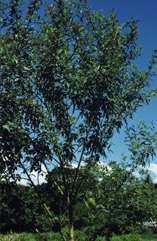
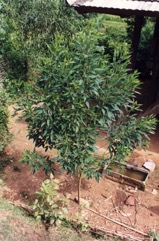
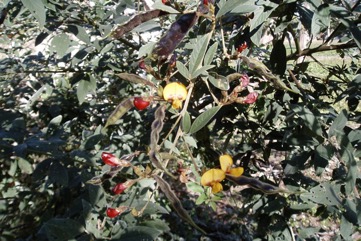
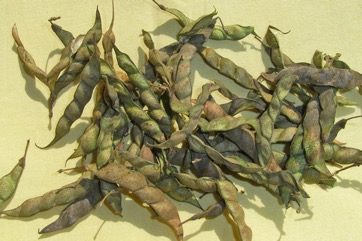
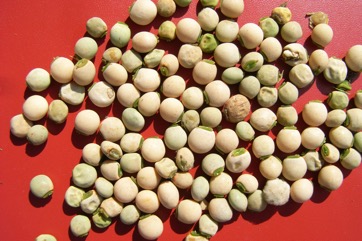
References
Abbiw, D.K., 1990, Useful Plants of Ghana. West African uses of wild and cultivated plants. Intermediate Technology Publications and the Royal Botanic Gardens, Kew. p 31
Ambasta S.P. (Ed.), 2000, The Useful Plants of India. CSIR India. p 94
Anderson, E. F., 1993, Plants and people of the Golden Triangle. Dioscorides Press. p 205
Ara, R. I. T., 2015, Leafy Vegetables in Bangladesh. Photon eBooks. p 95
Asfaw, Z., Conservation and use of traditional vegetables in Ethiopia. FAO
Bekele-Tesemma A., Birnie, A., & Tengnas, B., 1993, Useful Trees and Shrubs for Ethiopia. Regional Soil Conservation Unit. Technical Handbook No 5. p 124
Bennett, B. C., 1990, Useful Plants of Amazonian Ecuador. US Agency for International Development. Fifth Progress Report. New York Botanical Gardens. p 39
Bircher, A. G. & Bircher, W. H., 2000, Encyclopedia of Fruit Trees and Edible Flowering Plants in Egypt and the Subtropics. AUC Press. p 72
Bodkin, F., 1991, Encyclopedia Botanica. Cornstalk publishing, p 182
Bodner, C. C. and Gereau, R. E., 1988, A Contribution to Bontoc Ethnobotany. Economic Botany, 43(2): 307-369
Bourret, D., 1981, Bonnes-Plantes de Nouvelle-Caledonie et des Loyaute. ORSTOM. p 13
Brouk, B., 1975, Plants Consumed by Man. Academic Press, London. p 125
Bunderson, W. T. et al, 2002, Common Agroforestry Species in Malawi. Malawi Agroforestry Extension Project, Pubication No. 46, Lilongwe. p 27
Burkill, H. M., 1985, The useful plants of west tropical Africa, Vol. 3. Kew.
Burkill, I.H., 1966, A Dictionary of the Economic Products of the Malay Peninsula. Ministry of Agriculture and Cooperatives, Kuala Lumpur, Malaysia. Vol 1 (A-H) p 398 (As Cajanus indicus)
Cabalion, P. and Morat, P., 1983, Introduction le vegetation, la flore et aux noms vernaculaires de l'ile de Pentcoste (Vanuatu), In: Journal d'agriculture traditionnelle et de botanique appliquee JATBA Vol. 30, 3-4
Cao, Y., et al, 2020, Ethnobotanical study on wild edible plants used by three trans-boundary ethnic groups in Jiangcheng County, Pu’er, Southwest China. Journal of Ethnobiology and Ethnomedicine (2020) 16:66
Clarke, W.C. & Thaman, R.R.(Eds.), 1993, Agroforestry in the Pacific Islands: Systems for sustainability. United Nations University Press. New York. p 226
Cobley, L.S. (rev. Steele, W.M.) 2nd Ed., 1976, An Introduction to the Botany of Tropical Crops. Longmans. p 99
Creasy, R., 2000, The Edible Asian Garden. Periplus p 26
Cruz-Garcia, G. S., & Price, L. L., 2011, Ethnobotanical investigation of 'wild' food plants used by rice farmers in Kalasin, Northeast Thailand. Journal of Ethnobiology and Ethnomedicine 7:33
Cundall, P., (ed.), 2004, Gardening Australia: flora: the gardener's bible. ABC Books. p 276
Dansi, A., et al, 2008, Traditional leafy vegetables and their use in the Benin Republic. Genet Resour Crop Evol (2008) 55:1239–1256
Das, T. & Das, A. K., 2005, Inventorying plant biodiversity in homegardens: A case study in Barak Valley, Assam, North East India. CURRENT SCIENCE, VOL. 89, NO. 1, 10 JULY 2005
Dansi, A., et al, 2012, Diversity of the Neglected and Underutilized Crop Species of Importance in Benin. The Scientific World Journal. Volume 2012, Article ID 932947, 19 pages
Dhyani, S.K., & Sharma, R.V., 1987, Exploration of Socio-economic plant resources of Vyasi Valley in Tehri Garwhal. J. Econ. Tax. Bot. Vol. 9 No. 2 pp 299-310
Ekman Herbarium records Haiti (As Cajanus indicus)
Facciola, S., 1998, Cornucopia 2: a Source Book of Edible Plants. Kampong Publications, p 102
FAO, 1988, Traditional Food Plants, FAO Food and Nutrition Paper 42. FAO Rome p 130
Fowler, D. G., 2007, Zambian Plants: Their Vernacular Names and Uses. Kew. p 36
Fox, F. W. & Young, M. E. N., 1982, Food from the Veld. Delta Books. p 202
French, B.R., 1986, Food Plants of Papua New Guinea, A Compendium. Asia Pacific Science Foundation p 38
French, B.R., 2010, Food Plants of Solomon Islands. A Compendium. Food Plants International Inc. p 51
Fu, Yongneng, et al, 2003, Relocating Plants from Swidden Fallows to Gardens in Southwestern China. Economic Botany, 57(3): 389-402
Gangte, H. E., et al, 2013, Wild Edible Plants used by the Zou Tribe in Manipur, India. International Journal of Scientific and Research Publications, Volume 3, Issue 5
Gohre, A., et al, 2016, Plants from disturbed savannah vegetation and their usage by Bakongo tribes in Uíge, Northern Angola. Journal of Ethnobiology and Ethnomedicine (2016) 12:42
Goode, P., 1989, Edible Plants of Uganda. FAO p 39
Goode, P., 1989, Edible Plants of Uganda. FAO p 41
Gouldstone, S., 1983, Growing your own Food-bearing Plants in Australia. Macmillan p 168
Guite, C., 2016, A study of wild edible plants associated with the Paite tribe of Manipur, India, International Journal of Current Research. Vol. 8, Issue, 11, pp. 40927-40932
Hedrick, U.P., 1919, (Ed.), Sturtevant's edible plants of the world. p 141 (As Cajanus indicus)
Hu, Shiu-ying, 2005, Food Plants of China. The Chinese University Press. p 469
ILDIS Legumes of the World http:www;ildis.org/Legume/Web
Jabeen, A., et al, 2009, Indigenous uses of economically important flora of Margallah Hills National Park, Islamabad, Pakistan. African Journal of Biotechnology Vol. 8 (5), pp. 763-784
Japanese International Research Centre for Agricultural Science www.jircas.affrc.go.jp/project/value_addition/Vegetables Jardin, C., 1970, List of Foods Used In Africa, FAO Nutrition Information Document Series No 2.p 25, 62
Katende, A.B., Birnie, A & Tengnas B., 1995, Useful Trees and Shrubs for Uganda. Identification, Propagation and Management for Agricultural and Pastoral Communities. Technical handbook No 10. Regional Soil Conservation Unit, Nairobi, Kenya. p 144
Kays, S. J., and Dias, J. C. S., 1995, Common Names of Commercially Cultivated Vegetables of the World in 15 languages. Economic Botany, Vol. 49, No. 2, pp. 115-152
Kebebew, M. & Leta, G., 2016, Wild Edible Plant Bio-diversity and Utilization System in Nech Sar National Park, Ethiopia. International Journal of Bio-resource and Stress Management 2016, 7(4):885-896
Kiple, K.F. & Ornelas, K.C., (eds), 2000, The Cambridge World History of Food. CUP p 1834
Kuo, W. H. J., (Ed.) Taiwan's Ethnobotanical Database (1900-2000), http://tk.agron.ntu.edu.tw/ethnobot/DB1.htm
Latham, P., 2004, Useful Plants of Bas-Congo province. Salvation Army & DFID p 65
Latham, P. & Mbuta, A. K., 2014, Useful Plants of Bas-Congo Province, Democratic Republic of Congo. Volume 1. Salvation Army. p 93
Lautenschläger, T., et al, 2018, First large-scale ethnobotanical survey in the province of Uíge, northern Angola. Journal of Ethnobiology and Ethnomedicine (2018) 14:51
Lazarides, M. & Hince, B., 1993, Handbook of Economic Plants of Australia, CSIRO. p 41
Lembogi Biologi Nasional, 1980m Sayur-sayuran. Balai Pustaka, Jakarta. p 36
Llamas, K.A., 2003, Tropical Flowering Plants. Timber Press. p 216
Long, C., 2005, Swaziland's Flora - siSwati names and Uses http://www.sntc.org.sz/flora/
Macmillan, H.F. (Revised Barlow, H.S., et al) 1991, Tropical Planting and Gardening. Sixth edition. Malayan Nature Society. Kuala Lumpur. p 322
Malaisse, F., 1997, Se nourrir en floret claire africaine. Approche ecologique et nutritionnelle. CTA., p 59
Malaisse, F., 2010, How to live and survive in Zambezian open forest (Miombo Ecoregion). Les Presses Agronomiques de Gembloux.
Manandhar, N.P., 2002, Plants and People of Nepal. Timber Press. Portland, Oregon. p 126
Martin, F.W. & Ruberte, R.M., 1979, Edible Leaves of the Tropics. Antillian College Press, Mayaguez, Puerto Rico. p 198
Maundu, P. et al, 1999, Traditional Food Plants of Kenya. National Museum of Kenya. p 81
Mbuya, L.P., Msanga, H.P., Ruffo, C.K., Birnie, A & Tengnas, B., 1994, Useful Trees and Shrubs for Tanzania. Regional Soil Conservation Unit. Technical Handbook No 6. p 150
Medhi, P. & Borthakur, S. K., 2012, Phytoresources from North Cachur Hills of Assam -3: Edible plants sold at Hflong market. Indian Journal or Natural Products and Resources. 3(1) pp 84-109
Menninger, E.A., 1977, Edible Nuts of the World. Horticultural Books. Florida p 90
Miguel, E., et al, 1989, A checklist of the cultivated plants of Cuba. Kulturpflanze 37. 1989, 211-357
Molla, A., Ethiopian Plant Names. http://www.ethiopic.com/aplants.htm
Murtem, G. & Chaudhrey, P., 2016, An ethnobotanical note on wild edible plants of Upper Eastern Himalaya, India. Brazilian Journal of Biological Sciences, 2016, v. 3, no. 5, p. 63-81.
Mutie, F. G., 2020, Conservation of Wild Food Plants and Their Potential for Combatting Food Insecurity in Kenya as Exemplified by the Drylands of Kitui County. Plants 2020, 9, 1017
Nyadanu, D., et al, 2015, Agro-biodiversity and challenges of on-farm conservation: the case of plant genetic resources of neglected and underutilized crop species in Ghana. Genet. Resourc. Crop Evol. 62(7):
Ochse, J.J. et al, 1931, Vegetables of the Dutch East Indies. Asher reprint. p 371
Omawale, 1973, Guyana's edible plants. Guyana University, Georgetown p 79
Paczkowska, G . & Chapman, A.R., 2000, The Western Australian Flora. A Descriptive Catalogue. Western Australian Herbarium. p 419
Peekel, P.G., 1984, (Translation E.E.Henty), Flora of the Bismarck Archipelago for Naturalists, Division of Botany, Lae, PNG. p 261, 262
Pham-Hoang Ho, 1999, An Illustrated Flora of Vietnam. Nha Xuat Ban Tre. p 964
Phon, P., 2000, Plants used in Cambodia. © Pauline Dy Phon, Phnom Penh, Cambodia. p 119
Plants of Haiti Smithsonian Institute http://botany.si.edu/antilles/West Indies
Polunin, O., & Stainton, A., 2006, Flowers of the Himalaya, Oxford India Paperbacks. p 102
PROSEA (Plant Resources of South East Asia) handbook, Volume 1, 1989, Pulses.
Publ. Field Columbian Mus., Bot. Ser. 2:53. 1900
Purseglove, J.W., 1968, Tropical Crops Dicotyledons, Longmans. p 236
Rahmatullah, M., et al, 2009, A survey of medicinal plants in two areas of Dinajpur district, Bangladesh including plants which can be used as functional foods. American-Eurasian Journal of Sustainable Agriculture, 3(4): 862-876
Rashid, H. E., 1977, Geography of Bangladesh. Westview p 259 (As Cajanus indicus)
Recher, P, 2001, Fruit Spirit Botanical Gardens Plant Index. www.nrg.com.au/~recher/ seedlist.html p 1
Royes, W.V., 1979, Pigeon pea, in Simmonds N.W.,(ed), Crop Plant Evolution. Longmans. London. p 154
Royal Botanic Gardens, Kew (1999). Survey of Economic Plants for Arid and Semi-Arid Lands (SEPASAL) database. Published on the Internet; http://www.rbgkew.org.uk/ceb/sepasal/internet [Accessed 28th April 2011]
Rubaihayo, E. B., Conservation and use of traditional vegetables in Uganda. Bioversity International.
Ruiters-Welcome, A. K., 2019, Food plants of southern Africa. Ph.D. thesis. Univ. of Johannesburg p 56
Segnon, A. C. & Achigan-Dako, E. G., 2014, Comparative analysis of diversity and utilization of edible plants in arid and semi-arid areas in Benin. Journal of Ethnobiology and Ethnomedicine 2014, 10:80
Segura, S., et al, 2018, The edible fruit species in Mexico. Genet Resour Crop Evol (2018) 65:1767–1793
Self, M., 199, Phoenix Seeds catalogue. p 7
Shah, S. K., 2014, Dietary contribution of underutilized minor crops and indigenous plants collected from uncultivated lands and forests in Nepal. in Promotion of Underutilized Indigenous Food Resources for Food Security and Nutrition in Asia and Pacific. FAO. Bangkok p 64
Sina, B. & Degu, H. D., 2015, Knowledge and use of Wild Edible Plants in the Hula District of the Sidama Zone. International Journal of Bio-resource and Stress Management 6(3):352-365
Small, E., 2009, Top 100 Food Plants. The world's most important culinary crops. NRC Research Press. p 424
Smith, K., 1998. Growing Uncommon Fruits and Vegetables. New Holland. p 4
Solomon, C., 2001, Encyclopedia of Asian Food. New Holland. p 211
Srichaiwong, P., et al, 2014, A Study of the Biodiversity of Natural Food Production to Support Community Upstream of Chi Basin, Thailand. Asian Social Science 10 (2):
Staples, G.W. and Herbst, D.R., 2005, A tropical Garden Flora. Bishop Museum Press, Honolulu, Hawaii. p 308
Sujanapal, P., & Sankaran, K. V., 2016, Common Plants of Maldives. FAO & Kerala FRI, p 66
Sukenti, K., et al, 2016, Ethnobotanical study on local cuisine of the Sasak tribe in Lombok Island, Indonesia. Journal of Ethnic Foods. 3 (2016) 189-200 p 198
Swaziland's Flora Database http://www.sntc.org.sz/flora
Teron, R. & Borthakur, S. K., 2016, Edible Medicines: An Exploration of Medicinal Plants in Dietary Practices of Karbi Tribal Population of Assam, Northeast India. In Mondal, N. & Sen, J.(Ed.) Nutrition and Health among tribal populations of India. p 152
Terra, G.J.A., 1973, Tropical Vegetables. Communication 54e Royal Tropical Institute, Amsterdam, p 34
Thaman, R. R., et al, 1994, The Flora of Nauru. Atoll Research Bulletin No. 392. Smithsonian Institute p 138
Tindall, H.D., & Williams, J.T., 1977, Tropical Vegetables and their Genetic Resources, International Board for Plant Genetic Resources, Rome, p 77
Tindall, H.D., 1983, Vegetables in the Tropics, Macmillan p 254
USDA, ARS, National Genetic Resources Program. Germplasm Resources Information Network - (GRIN). [Online Database] National Germplasm Resources Laboratory, Beltsville, Maryland. Available: www.ars-grin.gov/cgi-bin/npgs/html/econ.pl (10 April 2000)
Vael, L., 2015, Ethnobotanical study of the plant use in the natural landscape of two mestizo communities in the Ucayali region of the Peruvian Amazon. Universiteit Gent.
van der Maesen, L.J.G., 2006. Cajanus cajan (L.) Millsp. [Internet] Record from Protabase. Brink, M. & Belay, G. (Editors). PROTA (Plant Resources of Tropical Africa), Wageningen, Netherlands. < http://database.prota.org/search.htm>. Accessed 14 October 2009.
van Wyk, B., 2005, Food Plants of the World. An illustrated guide. Timber press. p 111
van Wyk, Be, & Gericke, N., 2007, People's plants. A Guide to Useful Plants of Southern Africa. Briza. p 20
van Wyk, Ben-Erik, 2019, The diversity and multiple uses of southern African legumes. Australian Systematic Botany, 2019, 32, 519–546
Vasquez, R. and Gentry, A. H., 1989, Use and Misuse of Forest-harvested Fruits in the Iquitos Area. Conservation Biology 3(4): 350f (As Cajanus bicolor)
Verdcourt, B., 1979, Manual of New Guinea Legumes. Botany Bulletin No 11, Division of Botany, Lae, Papua New Guinea. p 539
Vickery, M.L. and Vickery, B., 1979, Plant Products of Tropical Africa, Macmillan. p 22
Walter, A. & Lebot, V., 2007, Gardens of Oceania. ACIAR Monograph No. 122. p 123
Williamson, J., 2005, Useful Plants of Malawi. 3rd. Edition. Mdadzi Book Trust. p 49
Wilson, J.M. & Witcombe, J.R., Crops for Arid lands, in Wickens, G.E., Goodin, J.R., and Field, D.V.,(Eds.) 1985, Plants for Arid Lands. Unwin Hyman, London, p 41
Wiriadinata, H., Ethnobotany of Economic Plants in the Baliem Valley, Jayawijaya, Irian Jaya, Indonesian Institute of Science, Bogor, Indonesia
Woodward, P., 2000, Asian Herbs and Vegetables. Hyland House. p 47
World Checklist of Useful Plant Species 2020. Royal Botanic Gardens, Kew
www.worldagroforestrycentre.org/sea/products/afdbases/af
www.worldagroforestrycentre.org/treedb/
Xu, You-Kai, et al, 2004, Wild Vegetable Resources and Market Survey in Xishuangbanna, Southwest China. Economic Botany. 58(4): 647-667.
Zaldivar, M. E., et al, 2002, Species Diversity of Edible Plants Grown in Homegardens of Chibehan Amerindians from Costa Rica. Human Ecology, Vol. 30, No. 3, pp. 301-316